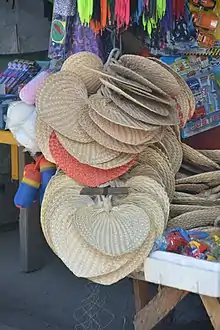
Pamaypay for sale in Iriga City, Philippines
Pamaypay (Tagalog pronunciation: [pɐmaɪˈpaɪ], puh-my-PY), also known as paypay, payupas, buri fan, or anahaw fan,[1][2][3] is a type of traditional hand-held fan from the Philippines. It is typically made of woven buri palm or anahaw palm leaves. It is usually heart-shaped, and woven in a technique known as sawali (twilled). The edges are braided and merges into a looped handle.[4] It is also typically made into wall decorations and other handicrafts.[5]
The term is also sometimes used for the abaniko, a folding hand fan used by the upper classes in the Spanish colonial period of the Philippines.[6][1]
See also
References
- 1 2 Calderón, Sofronio G. (1915). Diccionario Ingles-Español-Tagalog Con partes de la oracion y pronunciacion figurada. Manila: S. Martinez.
- ↑ Ella, Arsenio B.; Merida, Anie C. (2007). "Marketing of Anahaw (Livistona rotundifolia) fans to selected sites in Quezon Province, Philippines". 2007 D5 IUFRO All Division 5 Conference. Chinese Forest Products Association. p. 408.
- ↑ ""Payupas"". Pilipinaz Dictionary. Retrieved 17 July 2021.
- ↑ "Philippine Hand Fan: "Pamaypay"". Connecting Cultures Mobile Museum. Retrieved 17 July 2021.
- ↑ "Farmers from Canaman carve out business niche through abaniko with a twist". Japan International Cooperation Agency. 19 January 2017. Retrieved 17 July 2021.
- ↑ Scalice, Joseph (2009). Pasyon, Awit, Legend: Reynaldo Ileto's Pasyon and Revolution Revisited, a critique (MSc). University of California, Berkeley.
This article is issued from Wikipedia. The text is licensed under Creative Commons - Attribution - Sharealike. Additional terms may apply for the media files.